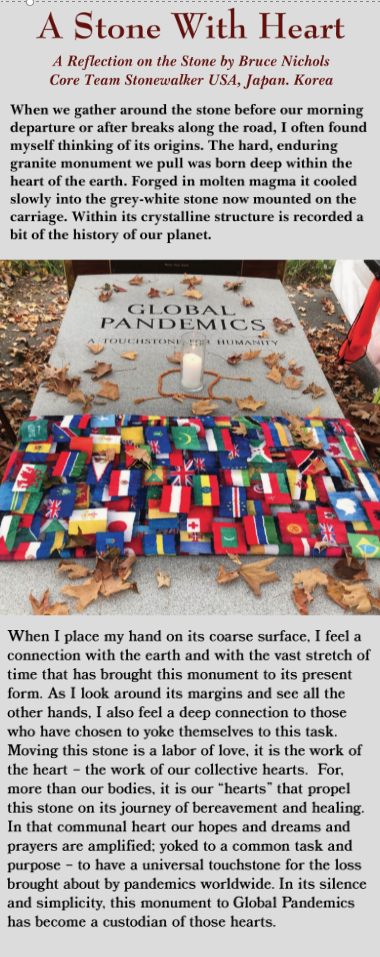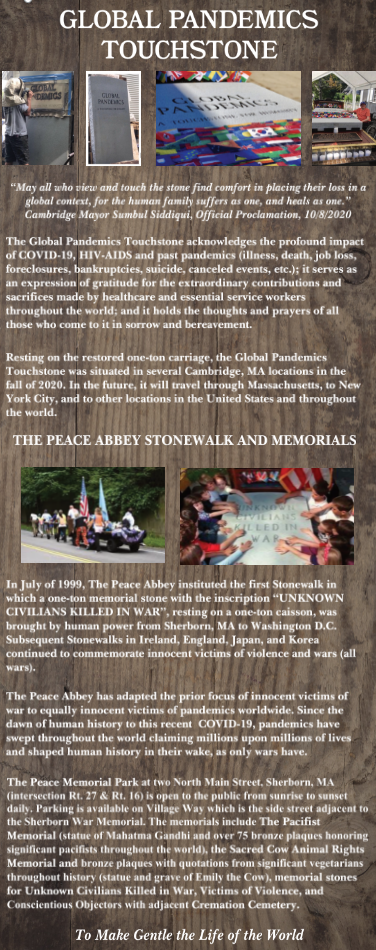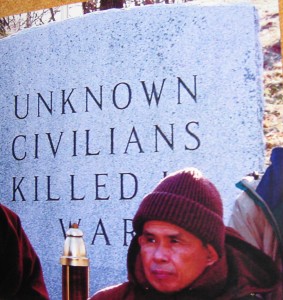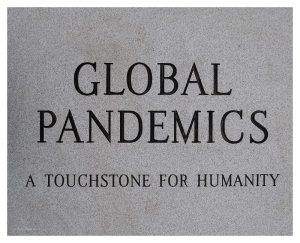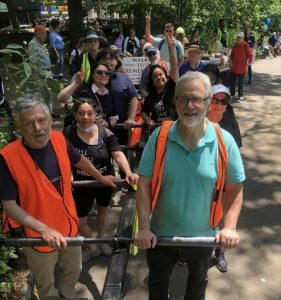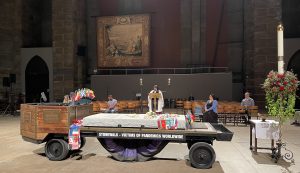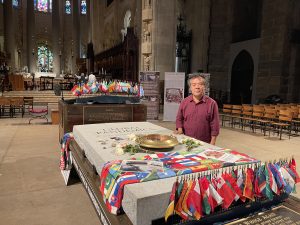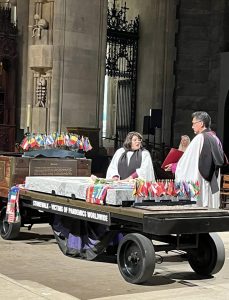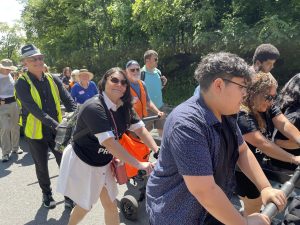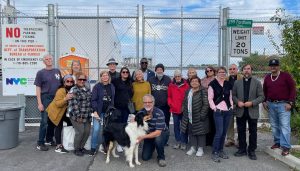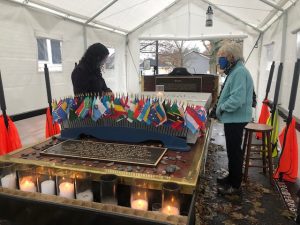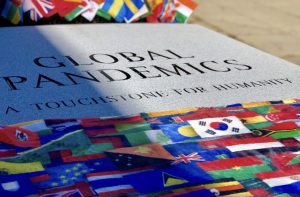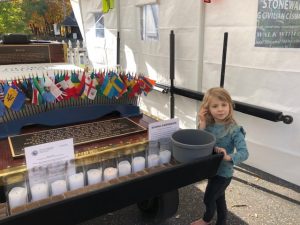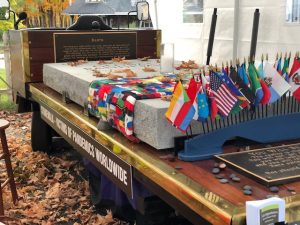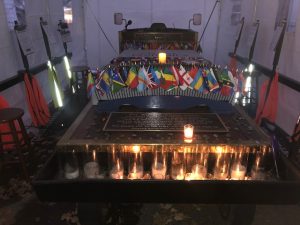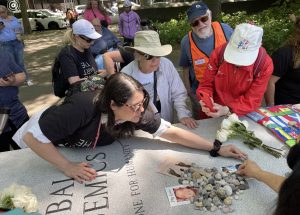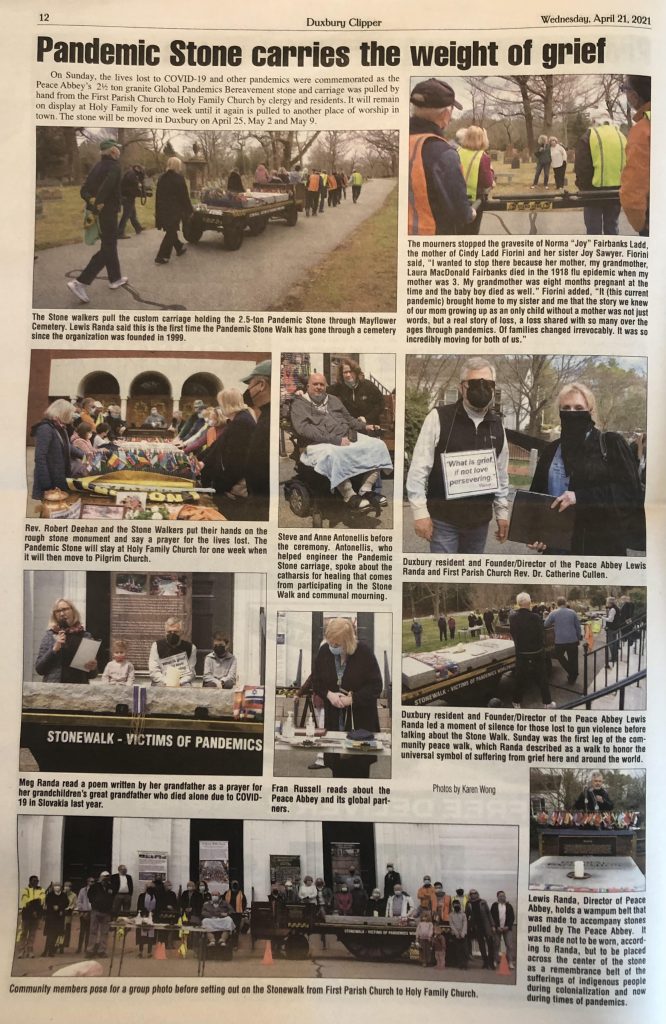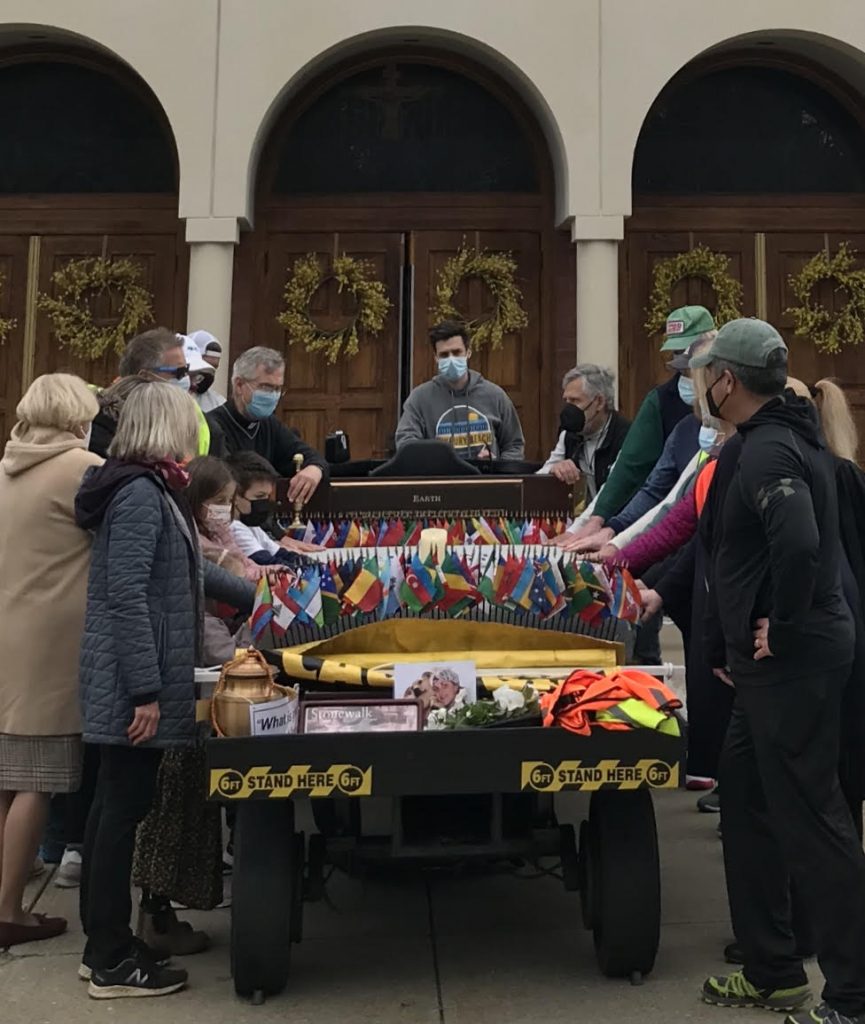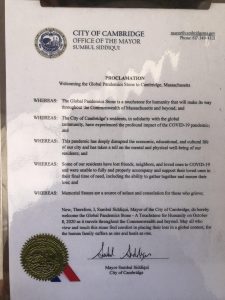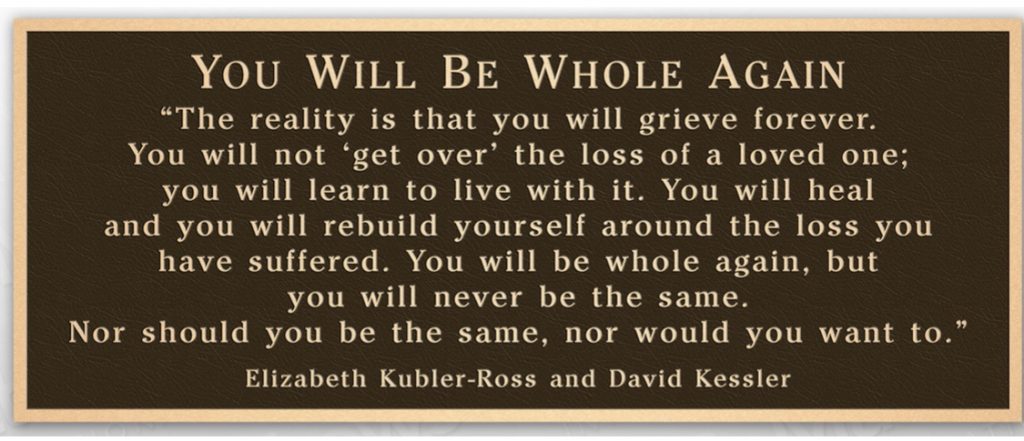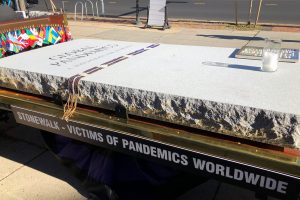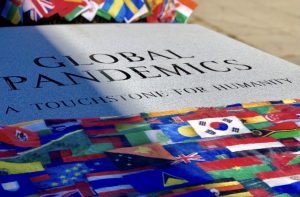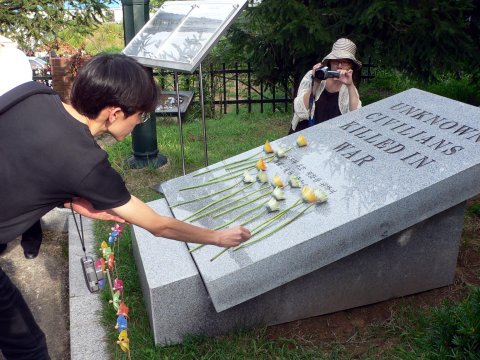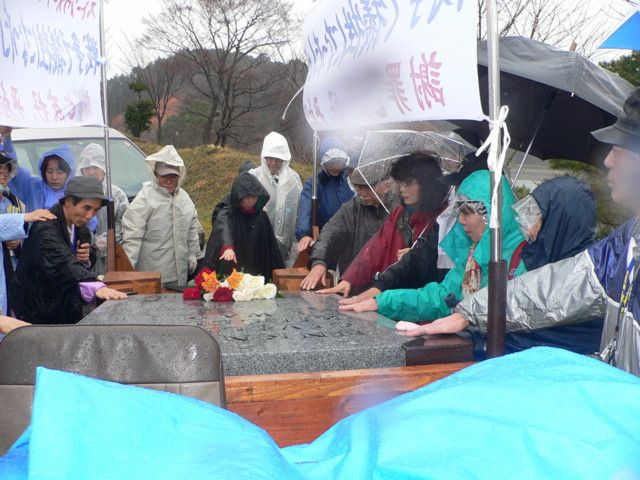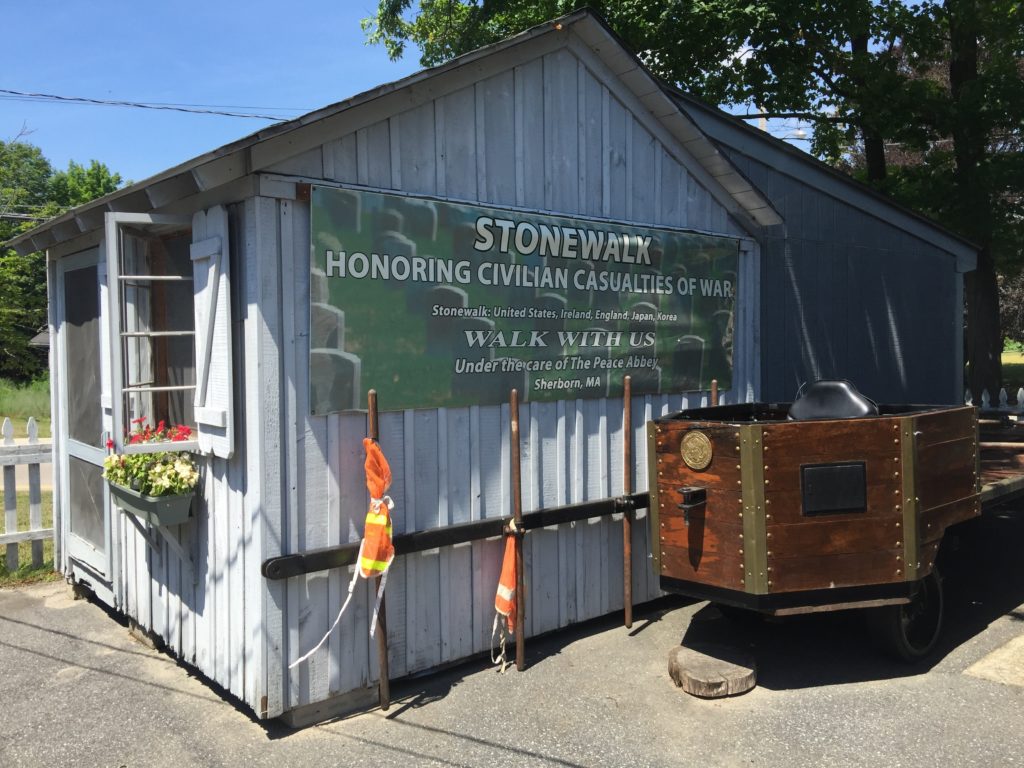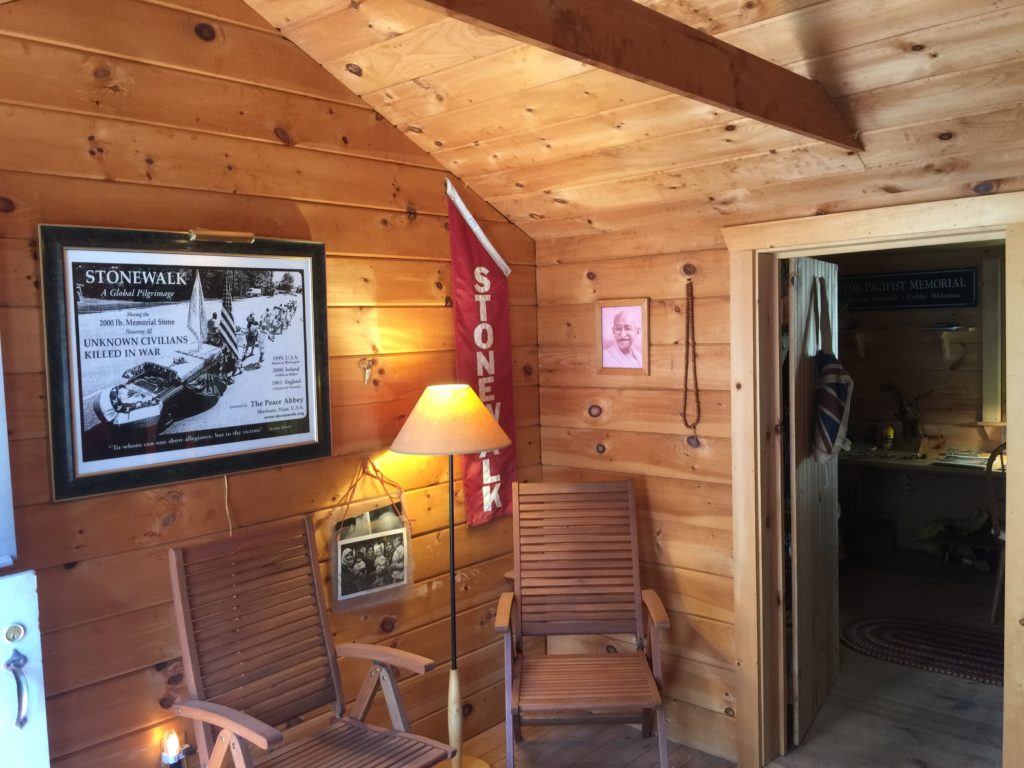GLOBAL PANDEMICS TOUCHSTONE
 Hart Island touchstone advocates will finally place their bereavement stone at the graveyard
Hart Island touchstone advocates will finally place their bereavement stone at the graveyard
The caisson is presently on Hart Island NYC holding the Global Pandemics Touchstone. Once the touchstone is permanently placed at the site where over one million New Yorkers are buried in mass, unmarked graves, it will be dispatched to the Middle East where it will carry a granite stone to be pulled between major locations where armed conflict has wreaked havoc on civilian populations.
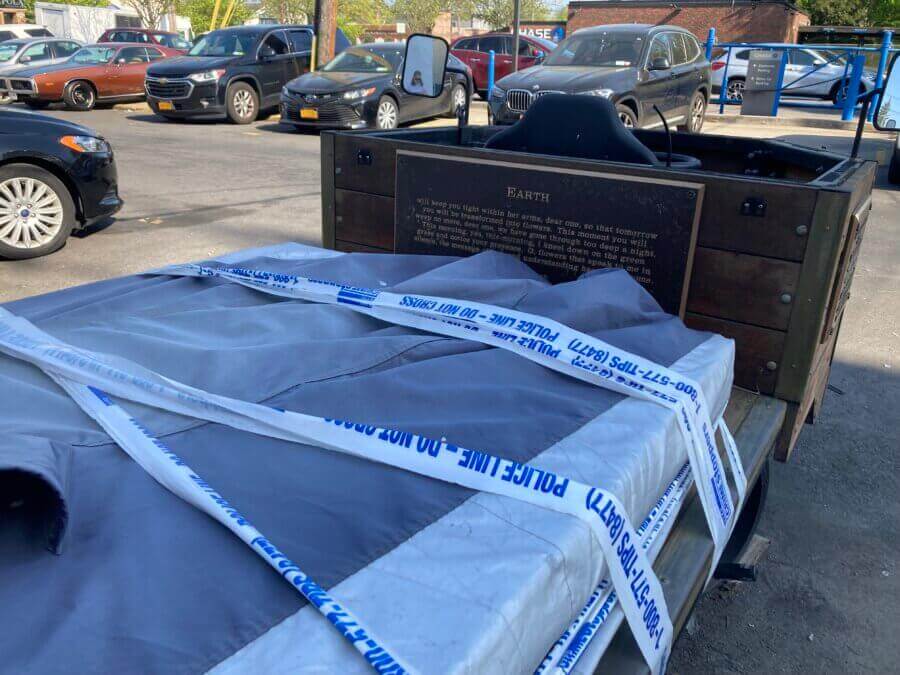
Soto has been campaigning for the city to place a bereavement stone on Hart Island for the better part of the past year — an initiative she says will finally give New Yorkers who are buried on the island, including her father, recognition. And after a memorial walk in Central Park planned for Sunday, the seven-foot tall, four-foot wide granite stone will be transported Tuesday out to the island at long last.
After running into bureaucratic roadblocks trying to get the stone out to Hart Island, the city approved the measure in March. According to a spokesperson from the NYC Department of Parks and Recreation, the memorial stone will be temporarily placed at the gazebo close to the entrance of the island, with the intent to get approval from the city Public Design Commission for permanent placement. NYC Parks has managed Hart Island since 2019 when it took it over from the Department of Corrections.
“Something that I always felt was necessary was a meaningful, respectable, dignified memorial,” Soto said. “We didn’t make these mistakes, but it doesn’t mean that we can’t right the wrongs of the past.”
Hart Island, which sits off the coast of City Island in the Bronx, is New York City’s mass public cemetery that serves as a final resting place for more than 1 million other New Yorkers. The majority of those buried there either “died indigent” or of epidemic or pandemic diseases, or their bodies went unclaimed after their death.
According to City Council data, the number of burials in the late 1980s through the early 1990s “increased markedly” — coinciding with the AIDS epidemic. Even more recently, officials were scrambling to make room for New Yorkers who died of COVID-19. A vast majority of the 1 million people who are buried on Hart Island were placed in unmarked graves, so many people have trouble locating their loved ones’ specific plots to this day.
When Soto’s father died from AIDS-related complications in 1993, she was just 9 years old. Back then, because of the nature of his death and how little medical personnel knew about the spread of the disease, she said there was a negative perception associated with his passing.
Soto’s family didn’t have a funeral for her father, which she said stunted her bereavement process as a child. Her dad’s body ended up in an unmarked grave on Hart Island, a grave that took Soto 20 years to find. But now, after three decades, she said she finally gets to give her dad the dignified memorial he deserves when she accompanies NYC Parks to Hart Island on Tuesday.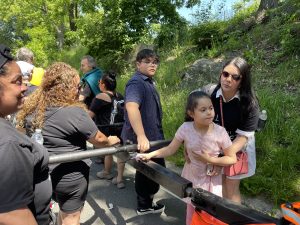
“This is truly going to be the homegoing service that a lot of us weren’t able to give,” she said. “A lot of us were kids at the time, so we didn’t have any control over the circumstances that we were given.”
The Hart Island Touchstone Coalition, a group of advocates that Soto serves as the NYC coordinator for, received the bereavement stone with the words “Global Pandemics; Touchstone for Humanity” from the Peace Abbey Foundation in September 2022. The Massachusetts nonprofit aims to create and install public works of art that promote peace.
Soto said the donation has helped to dispel negative stereotypes about New Yorkers buried on the island. And after the city approved the stone for temporary placement on the island earlier this spring, she said she felt gratified that more people were deeming the cemetery worthy.
Soto said she went to see the stone this week at an auto repair shop in Throggs Neck, where mechanics are repairing the stone’s trailer tires and polishing the trailer’s wood.
“It’s a ton of granite, but it felt so soft. It felt so comforting,” she said. “I think when people really get to see it and really get to touch it and then print their hands on the stone, they can truly appreciate the magnitude of healing that it has.”
While planning for her dad’s memorial service, Soto said she’s been emotional. Right now she’s in the process of choosing music to play at his gravesite that she said will “represent the person that he was” — which was one of many in the Latino community who was impacted by the HIV/AIDS epidemic in the 1980s and ‘90s.
After all this, Soto said she’s ready to break more negative health care stigmas. She’s currently studying public health, which she said she hopes will equip her to continue advocacy work in the future.
From this process she said she’s gained what she describes as a new family of people whose loved ones, for one reason or another, ended up on the island. And the bereavement stone, she said, is symbolic of that support system.
“Together we are a family,” she said. “It’s for everyone. It’s not just for my dad, not just for AIDS, it’s also for COVID and any type of epidemic that someone has faced that has led them to Hart Island.”
Peace Abbey Creates a Symbol of Unity in Sorrow
Nov 28, 2020 12:41PM ● By Judy O’Gara
In an upside-down world where human beings can’t touch each other, The Peace Abbey Foundation, located now in Millis, Massachusetts, has created a palpable symbol of global unity, with a one-ton stone that acknowledges the weight of a shared grief.
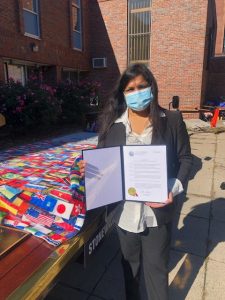 Bereaved families and friends of those who died from COVID19 or AIDS are invited to share their grief and loss by placing flowers, a photo or a small stone on the memorial, or to help pull the heavy tablet, via a carriage built for this purpose to its next public viewing location. As part of the National Week of Mourning, the stone was recently pulled from the Swedenborg Chapel in Harvard Square to the Salvation Army in Central Square, Cambridge, where Cambridge Mayor Sumbul Siddiqui read a proclamation welcoming the stone to the city. Calling it “a touchstone for humanity that will make its way throughout the Commonwealth of Massachusetts and beyond,” the Cambridge mayor’s proclamation asserted her city’s “solidarity with a global community and the profound impact, including the physical and mental toll COVID-19 has taken on the community, some of whom lost loved ones to the pandemic and who have been unable to gather to mourn their losses.”
Bereaved families and friends of those who died from COVID19 or AIDS are invited to share their grief and loss by placing flowers, a photo or a small stone on the memorial, or to help pull the heavy tablet, via a carriage built for this purpose to its next public viewing location. As part of the National Week of Mourning, the stone was recently pulled from the Swedenborg Chapel in Harvard Square to the Salvation Army in Central Square, Cambridge, where Cambridge Mayor Sumbul Siddiqui read a proclamation welcoming the stone to the city. Calling it “a touchstone for humanity that will make its way throughout the Commonwealth of Massachusetts and beyond,” the Cambridge mayor’s proclamation asserted her city’s “solidarity with a global community and the profound impact, including the physical and mental toll COVID-19 has taken on the community, some of whom lost loved ones to the pandemic and who have been unable to gather to mourn their losses.”
Peace Abbey Chaplain Dot Walsh, explains that this stone, like others The Peace Abbey has created, was made to travel. On its journey, it may find a home. The Peace Abbey’s other stones have had impact all over the world. In 1994, The Peace Abbey created the Unknown Civilians Killed in War stone, which was unveiled by Muhammed Ali. Since that time, that stone has traveled in the United States, Ireland, England and Japan. “The stone makes its way through the world, and then, if a public site or religious organization wishes to keep it, we give it to them and make another,” says Randa.
The original Unknown Civilians Killed in War stone, for example, is kept at the Coventry Cathedral in England. Walsh explains that another Unknown Civilians Killed in War stone found its way to Japan after its presence at Ground Zero in 2004 in New York. People who’d lost others to the violence of 9/11 touched the stone and shared their stories. A non-violence group from Japan happened to be visiting Ground Zero, among them a “hibakusha,” or survivor of the atomic bombing in Hiroshima during WWII. They expressed interest to Peace Abbey members to bring the stone to Japan. And so, that stone went overseas, to Asia, where the
American peace activists participated in pulling it over 375 miles from Nagasaki to Hiroshima, expressing sorrow at the loss of life and injury caused by the bomb. It arrived on the 60th anniversary of the dropping of the atomic bomb.
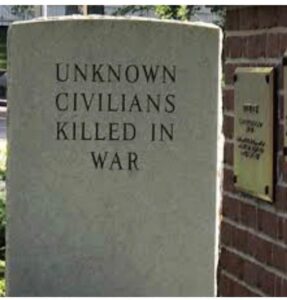 “Governments don’t apologize, but individuals can,” says Walsh. Participants in Japan, she says, were so touched, they asked to keep and care for the stone. They even created their own replica to present to Korea as a peace offering. Walsh says the world needs this Global Pandemics Touchstone in the same way, to heal. “Even the people who work in the hospitals,” she says, “it’s just so overwhelming that at the end of the day, they cry, and they go home exhausted. They need something like this stone. This stone has meaning for people all over the world.”
“Governments don’t apologize, but individuals can,” says Walsh. Participants in Japan, she says, were so touched, they asked to keep and care for the stone. They even created their own replica to present to Korea as a peace offering. Walsh says the world needs this Global Pandemics Touchstone in the same way, to heal. “Even the people who work in the hospitals,” she says, “it’s just so overwhelming that at the end of the day, they cry, and they go home exhausted. They need something like this stone. This stone has meaning for people all over the world.”
Although The Peace Abbey had had plans to create another stone honoring innocent victims of war, “When the pandemic happened, it was clear there was another message that needed to be expressed with the current struggle of humanity,” says Randa. Pulling the stone with others, says Randa, is an effort that requires one “to dig deep within yourself to muster the strength to move it. It could have been lighter, but we chose to have the weight of the stone reflect the weight of its message.” Randa notes that, as long as social distancing and mask protocols are followed, “anyone who might find solace in visiting the stone” is welcome at its Millis location. “We’d like the public to know that, upon request, much as with families who lost loved ones on 911, we will organize short bereavement Stonewalks, if those who wish to participate are within safe, family units,” says Randa.
 GLOBAL PANDEMICS STONE ON TOUR
GLOBAL PANDEMICS STONE ON TOUR
The Salvation Army’s Cambridge, Mass., Corps teamed up with the Peace Abbey Foundation, an organization that creates and installs public works of art that promote peace and nonviolence. In times of national and worldwide crisis, Peace Abbey has used commemorative stones to honor innocent lives devastated by gun violence and war.
This year, The Global Pandemics stone, which has been a memorial for victims of AIDS, will also acknowledge the ways that COVID–19 has affected the world through sickness, death, job loss, home foreclosures, and canceled events. As travel regulations permit, the hope is that the stone will make its way across Boston, New York, and the country.
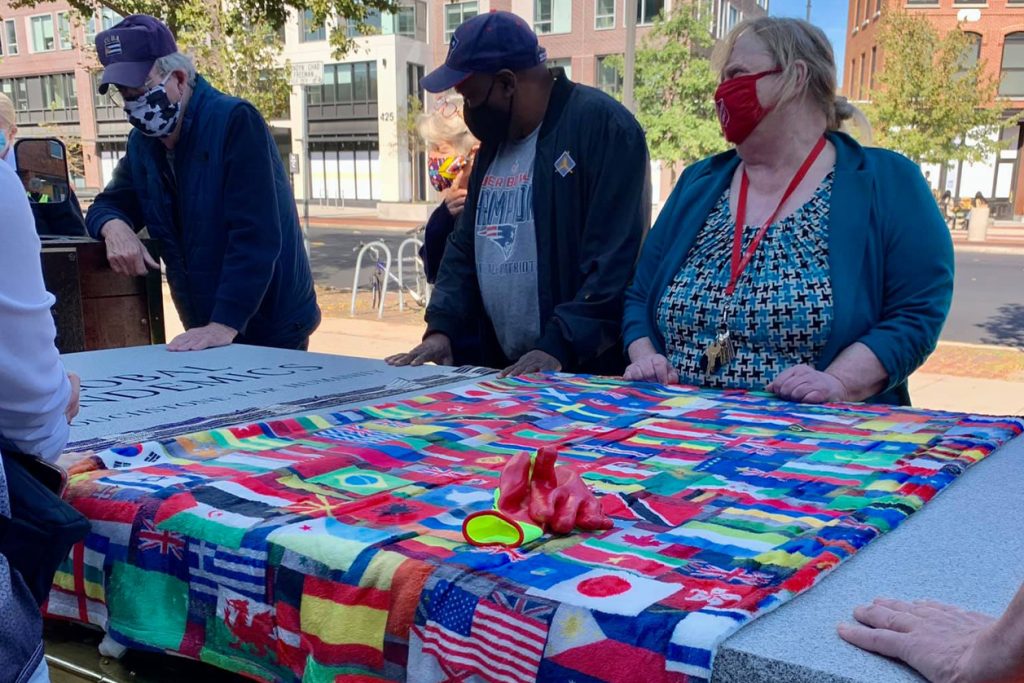 FACING CHALLENGES AS ONE
FACING CHALLENGES AS ONE
One day, Lewis Randa, founder and chair of Peace Abbey, drove down Massachusetts Avenue in Cambridge. He noticed rose bushes as they adorned the front of the Salvation Army corps. He also saw that the Army resided next to the city’s fire department.
Lieutenant Elizabeth Carvill, assistant corps officer at the corps, remembers Randa saying, “The Salvation Army is a beautiful, safe location.” Randa contacted Majors Douglas and Judy Hart, corps officers, and arranged for the corps to be the Global Pandemic Stone’s second stop.
On the first Sunday in October, members of Peace Abbey towed the one–ton stone on a cart from its first stop, Swedenborg Chapel in Harvard Square, and placed it in front of the Cambridge Corps. Lieutenant Carvill offered a blessing, saying she hoped that, in this space, the community would find comfort and the peace of God.
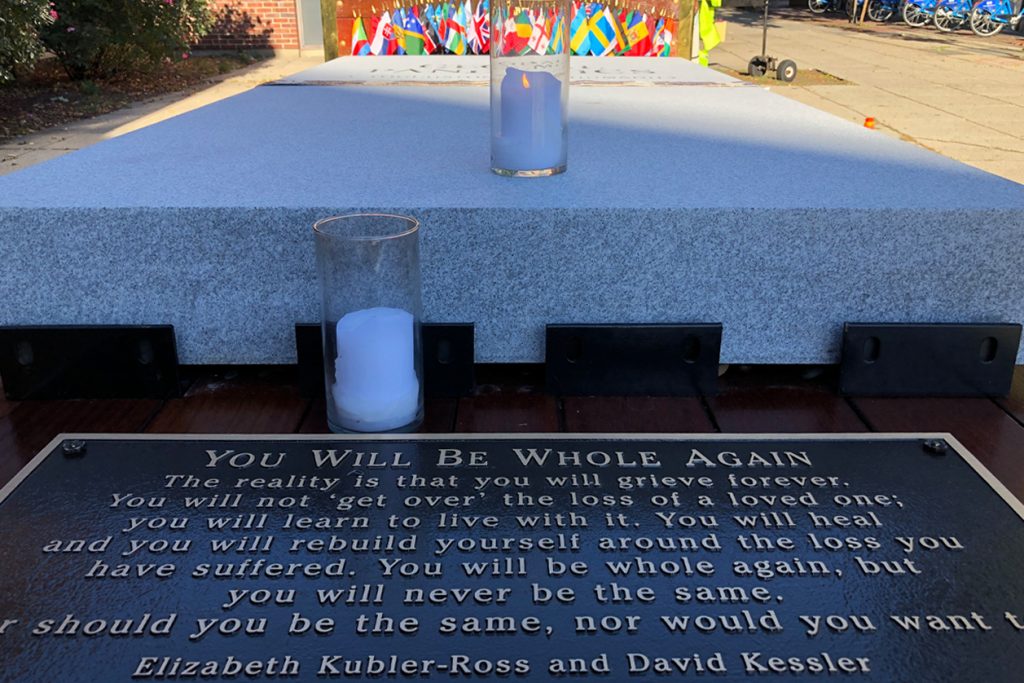 “The stone is considered a living thing,” said Carvill. “The weather affects it, and it changes color over time. When you touch the stone, it takes the oils from your hand. Those oils mix with the oils of other people who have placed their hands on it. It symbolizes that, whatever we are all going through, we go through it together.”
“The stone is considered a living thing,” said Carvill. “The weather affects it, and it changes color over time. When you touch the stone, it takes the oils from your hand. Those oils mix with the oils of other people who have placed their hands on it. It symbolizes that, whatever we are all going through, we go through it together.”
Every night the stone stood in front of the Salvation Army building, a member of the corps would carefully cover it. In the morning, someone removed the cover so that it could be clearly seen by motorists and pedestrians along the busy avenue.
A MAYOR’S WELCOME
The following Thursday, Cambridge Corps members held a ceremony in recognition of the National Week of Mourning. “The numbers are not just people who have died,” said Karen Meehan, corps sergeant major and director of operations at the corps. “They are our mothers, fathers, sisters, brothers, aunts, and uncles.” To date, the state of Massachusetts has had over 144,000 COVID–19 cases and close to 10,000 deaths.
Cambridge Mayor Sumbul Siddiqui was a guest at the event. It was the mayor’s first visit to the corps. While enthusiastically introducing the mayor, Carvill compared her to singer Beyonce Knowles. “Just as Beyonce said, ‘Who runs the world? Girls!’ Who runs the city of Cambridge? Our Mayor Siddiqui!”
Siddiqui said, “May all who view and touch the stone find comfort in placing their loss in a global context, for the human family suffers as one, and heals as one.”
After the event, Suddiqui toured the Cambridge Corps and learned about its programs, such as the Our Place day care center and the Bridging the Gap program. Carvill said, “We also spoke to the mayor about the importance of having a database of social service needs. It’s important for us to know who we are helping and how.
“Even though we have not been able to serve in full capacity, we still serve three meals a day, with proper social distancing parameters,” says Carvill. “It has been a great blessing that the Cambridge Corps has remained open during the pandemic, while many other service providers have had to close their doors.”
by Hugo Bravo
Cambridge Mayor Speaks at Global Pandemics Stone
The Global Pandemics Stonewalk Project welcomes bereaved families, spouses, and friends of those who died from COVID-19 or AIDS to share their grief and loss by placing flowers, a photo or small stone on the international pandemics stone and by helpIng pull the one-ton memorial stone to its next scheduled public viewing location. The stone will be part of the National Week of Mourning. It presently is at the Salvation Army in Central Square, Cambridge.
During the Proclamation Ceremony on Thursday, Cambridge Mayor Sumbul Siddiqui spoke of the importance of the Global Pandemics stone and toured the Salvation Army Center with Lt. Carvill and other members of the staff.
The Global Pandemics stone was cut from the same quarry in Vermont and engraved by the same stonecutters who carved the stone for Unknown Civilians Killed in War which the Peace Abbey created in 1994. The civilian stone was pulled through the US, Ireland, England, Japan and Korea over the past 20 years and attracted thousands of people since it was unveiled in ‘94 by Muhammad Ali at The Peace Abbey. To this day it serves to remind us that nine out of ten people killed in war are innocent civilians. Wars tragically shape human history in their wake, as do pandemics from time immemorial. These two stones speak in tandem of the hardships and struggles our species has endured when death sweeps across continents with unspeakable disregard for those in its path.
 To date, as you know too well, over two hundred thousand Americans and over one million people throughout the world drew their last breath due to the coronavirus. Memorials to COVID-19 casualties will be created throughout the world, and they will have one thing in common, they will not move. The global pandemics stone was created specifically to be moved, so as to move hearts on the long and difficult road of bereavement — where grief, sympathy, healing and compassion merge. Like war itself,. Pandemics have swept throughout the world claiming millions upon millions of innocent lives.
To date, as you know too well, over two hundred thousand Americans and over one million people throughout the world drew their last breath due to the coronavirus. Memorials to COVID-19 casualties will be created throughout the world, and they will have one thing in common, they will not move. The global pandemics stone was created specifically to be moved, so as to move hearts on the long and difficult road of bereavement — where grief, sympathy, healing and compassion merge. Like war itself,. Pandemics have swept throughout the world claiming millions upon millions of innocent lives.
This pandemics touchstone uniquely puts one’s grief in a global context. To the touch, the stone’s hard, cold, coarse surface is braille for the human suffering it embodies. It speaks in the silence of our grief and serves as a prayer for health and healing during these difficult times – it offers a way of acknowledging how people have been victimized by COVID -19 (illness, death, job loss, foreclosures, bankruptcies, canceled events, etc.) and speaks to the extraordinary contributions and sacrifices made by healthcare and essential service workers throughout the world.
Sad that so many people passed away without the comfort of loved ones at their side, with no funeral or memorial to help bring closure for their families, with little understanding of how this novel virus came to have the last word in their lives.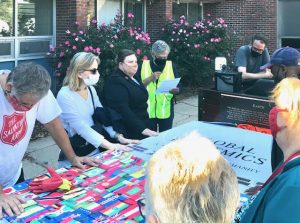
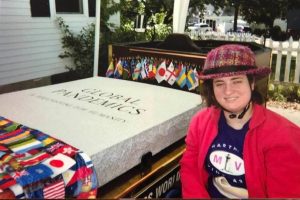
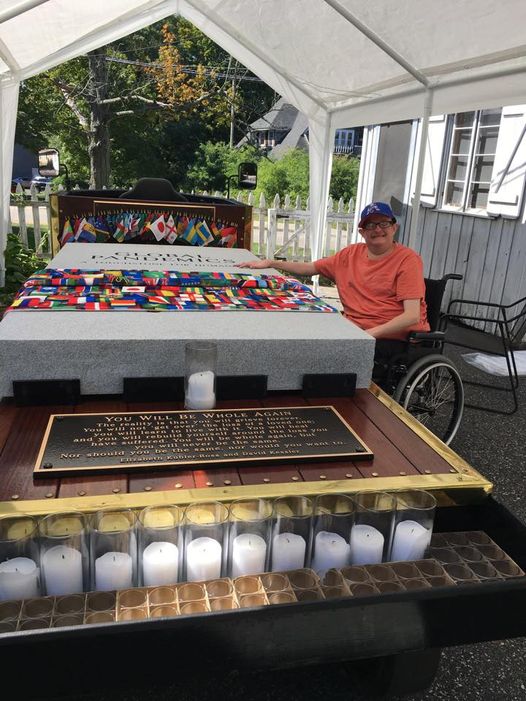
FREQUENTLY ASKED QUESTIONS ABOUT STONEWALK USA 1999
Why a memorial stone for civilians killed in war?
Civilians die in action as surely and as finally as any soldier. They also die from the consequences of war: shattered infrastructures, poisoned water, and land abandoned land mines, and other ordnance. Civilians deserve to be remembered. By honoring slain civilians, we understand and acknowledge the gravity of war and the full extent of its cost. With that acknowledgment comes an even deeper reverence for those in or out of uniform who paid the cost with life itself. The victims offer us an opportunity for reflection and transformation. Acknowledging what has transpired, we may yet imagine alternatives for a better century, and weave an intricate web of loving-kindness. In the words of poet Stanley Kunitz, “To whom can one pledge one’s allegiance except to the victims?” That is, to those who speak in silence, on behalf of our children and of ourselves.
Why A Civilian Memorial at Arlington Simple acts bring healing. The placing of this simple stone in a quiet space within the Arlington cemetery may open up space within the heart. Those who visit will be moved by what they see: the sea of headstones, the stately somber buildings, this simple memorial. And when they leave, the memory of this place will help them to renew their commitment to those ends desired by soldiers and pacifists alike: freedom, justice, and peace. Soldiers and civilians die together. At Arlington National Cemetery, together, may we remember them.
Simple acts bring healing. The placing of this simple stone in a quiet space within the Arlington cemetery may open up space within the heart. Those who visit will be moved by what they see: the sea of headstones, the stately somber buildings, this simple memorial. And when they leave, the memory of this place will help them to renew their commitment to those ends desired by soldiers and pacifists alike: freedom, justice, and peace. Soldiers and civilians die together. At Arlington National Cemetery, together, may we remember them.
Isn’t Arlington National Cemetery just for the military?
Over 200,000 Americans are buried within the grounds of Arlington Cemetery’s 612 acres, including generals and privates, presidents, politicians, and civilians. Arlington National Cemetery is primarily a burial ground for the military but contains memorials to civilians as well. One of the more recent is the Memorial to the Challenger Space Shuttle victims, which contains the combined remains of the seven crew members, including Christa McCauliffe, our nation’s first civilian teacher to be launched into space.
Has permission been granted for the Memorial Stone to be installed at Arlington National Cemetery?
The Memorial Stone is being offered as a gift, and STONEWALK is the journey to bring this gift of honor to Arlington National Cemetery. In this spirit, we are not asking permission to present this gift. There is a place at Arlington National Cemetery for the Memorial Stone, and the best place is outside the Amphitheater near the Tomb of the Unknown Soldier. Two of the co-sponsoring organizations, Veterans for Peace and Women’s Action for New Direction, are working with legislators to obtain an Act of Congress allowing the Memorial Stone to be placed in Arlington. So while approval has not yet been received, we are proceeding with full confidence that our government will honor the civilian victims at Arlington National Cemetery.
Which wars are referenced by the Memorial Stone?
The Memorial Stone is for Unknown Civilians Killed in War since the beginning of our nation. This includes all armed conflicts fought without the official declaration of war, as in Korea. The victims began with the Native Americans and sadly continue today in Iraq and Kosovo. It is important to remember that the destruction of wars continue for years after the hostilities cease, through direct means such as abandoned land mines as well as the diseases and despair from shattered families and infrastructure.
Why was Muhammad Ali chosen to unveil the Memorial Stone?
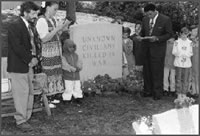 Muhammad Ali has dedicated his life to promoting world peace and social justice and has made numerous international peacemaking trips since his days as the heavyweight champion. He is committed to making the world a better place for children.
Muhammad Ali has dedicated his life to promoting world peace and social justice and has made numerous international peacemaking trips since his days as the heavyweight champion. He is committed to making the world a better place for children.
Why unknown civilians? Didn’t their families know and bury them already?
Just as there are remains of soldiers that are not able to be identified after a conflict, civilians have been killed without their remains being identified. Families are displaced and the survivors may not know the whereabouts or details of their deaths. Mass graves of unidentified bodies exist all over the globe. The Memorial Stone provides a place of reflection for us all.
Are there remains of civilians buried with the Memorial Stone?
No civilian’s remains are interred with the Stone, which stands as a symbol for their deaths.
Why now? Is there a reason STONEWALK will happen this summer?
This year brings to close a century of wars that is unparalleled in world history. In this century of two world wars, nuclear armaments and other weapons of mass destruction were used with terrible consequences for civilians. Bombs are being dropped on Yugoslavia, and civilians are being systematically targeted by troops. Tragically, civilians unknown to us are being killed every day. We need reminders to realize the lessons of history. Now is the time to recognize the true cost of war.
STONEWALK ADDRESS
Delivered by Lewis Randa on the Arlington Memorial Bridge
August 6, 1999
We stand at mid-point over Arlington Memorial Bridge and proclaim this very bridge to be the one we as a people must travel over to enter into the 21st Century.
And it is here, halfway over the Potomac that Stonewalk temporarily suspends its efforts to bring America’s only memorial for Unknown Civilians Killed in War to Arlington National Cemetery. Though its arrival is way overdue, and its message embodies an idea whose time has come, our elected and appointed officials have no idea how to accept it. Accepting this stone, of course, means understanding and accepting its message. Collateral damage, the euphemism used to describe civilian deaths, is not only obsolete, like war itself, but is insensitive, insulting and dehumanizing. It provides governments and those governed with a comfort zone for the death and destruction of innocent people and the social fabric upon which they must depend for survival — not to mention the wholesale slaughter of defenseless animals of land, air, and sea.
We proudly pulled the stone here in an attempt to educate and inspire those we met along the way, and we sought to soften hardened hearts and affirm hearts already open. We chose the arduous task of physically pulling this slab of granite to our nation’s capital because we feel there is a great deal of penance to perform for the tens of millions of children, sisters and brothers and mothers and fathers that we have killed over centuries unintentionally, and at times, by design with deliberate and calculated malice. We have as a people become numb not only to civilian deaths but to our own sense of shame.
Having just completed our 500-mile journey from the grounds of The Peace Abbey in Sherborn, Massachusetts over a period of 33 days, we stand here at mid-point on the Arlington Memorial Bridge to temporarily conclude our journey — for this stone has no home. Like the multitude of war refugees throughout the world, it is denied entry to its final destination for it has no papers, lacks signatures on official documents — the weight of its message too heavy to bother with for a government that couldn’t be bothered.
Were we to complete the journey today, and bring it to Arlington, the stone would be discarded, rejected like the very message it embodies. This is the official position of Arlington, America’s most sacred shrine. So out of respect for this stone and millions of voiceless civilian victims whose lives it honors, and out of respect for Arlington and those who were laid to rest there, we shall postpone that day of reckoning.
But we shall meet again, here on this bridge to the 21st Century, once Congress has passed legislation to accept the stone so we can complete our journey to Arlington. We shall return to this very spot so we can, in good faith, complete what we set out to do on the final Independence Day of the 20th century.
This moment is difficult, indeed, for all who shouldered the effort to bring this stone here. But it is nothing compared to what millions of families go through when armies advance, bombs are dropped and news arrives that a loved one is dead. Our dream of a civilian memorial is not dead. It simply requires that so long as we draw breath, we work and pray and struggle in every way possible to see this mission through. We will someday complete this journey. We simply brought our country a gift of conscience, and our country couldn’t find a way to accept it. “So with a good conscience, our only sure reward … let us go forth,” in the words of President Kennedy, “to serve the land we love, asking his blessings and his help, but knowing that here on Earth, God’s work must truly be our own.”
POSTPONED: STONEWALK 2020
GETTYSBURG TO WASHINGTON DC
Memorial for Unknown Civilians Killed in War
The Peace Abbey is gratified to announce that the memorial stone honoring Unknown Civilians Killed in War will be placed on public display at the Nipponzan-Myōhōji Buddhist Temple in Washington DC during the inaugural year of its annual rotation at religious sites in our nation’s capital.
Touching the hearts of those who visit, the storied civilian memorial stone serves as a reminder of the true cost of war. It will travel annually to different places of worship (churches, synagogues, temples, mosques, gurdwaras, et al.) until such time that it is permanently placed at either Arlington National Cemetery or Washington National Cathedral.
Why Stonewalk Gettysburg?
Sacred Stone — Sacred Land
It may seem a strange idea: People from different parts of the country joining with members of the Gettysburg community in order to pull a 2000 pound memorial stone to Washington DC. With an estimated 50 thousand civilian casualties during the Civil War, why begin the walk at the grave of the only civilian killed during the Battle of Gettysburg, Jennie Wade?
And what, one might ask, “can a stone do or say in recognizing the sacrifices of war? This does seem a strange idea.
This memorial stone, dedicated to Unknown Civilians Killed In War, is the counterpart to the Tomb of the Unknown Soldier. Those pulling the stone will include veterans, elected officials, clergy, families, people of all ages and backgrounds, all with a common desire that there be a place in Washington where civilian casualties in war are recognized; recognized in the spirit of how Gettysburg recognizes Jennie Wade.
The procession is called Stonewalk, and while it may seem strange, it is also strangely appropriate as the Stone speaks for itself in the silence of its message: Unknown Civilians Killed in War.
It is our hope and prayer that the movement of the memorial stone from Gettysburg to Washington DC will be a small, yet important expression of our shared grief and common desire to live in peace so there will no longer be a need for more war memorials.
_______________________________________________________
GLOBAL CIVILIAN STONES
Civilian stones throughout the world (Ireland, England, Japan, Korea) serve as a reminder of the true cost of war.
The original stone, which remains at the Pacifist Memorial in Sherborn, Massachusetts, serves as a touchstone where prayers for peace are continually offered and commitments to the peace
making are strengthened.
Together these stones link the suffering of innocent victims of armed conflict.
If stones could weep, surely these stones would, as they pay respect to the
Unknown Civilians Killed in War.
________________________________________________________
“I refuse to raise my child to grow up to kill another mother’s child”
It was 150 years ago, while in the wake of the American Civil War and in opposition to the Franco-Prussian War, that the first Mother’s Day in America came to be. Julia Ward Howe, who had earlier penned the well-known Battle Hymn Of The Republic, was later horrified by the carnage brought about by the Civil War and in a commitment to international peace she authored the Mother’s Day Peace Proclamation in 1870.
Howe’s vow of “I refuse to raise my child to grow up to kill another mother’s child” was at the time shared by mothers from all around to include Anna Reeves Jarvis of West Virginia who had worked to reconcile Americans from both sides of the Civil War.
Mother’s Day Proclamation by Julia Ward Howe
Arise, then, women of this day!
Arise, all women, who have hearts,
Whether our baptism be of water or of tears!
Say firmly:
“We will not have great questions decided by irrelevant agencies,
Our husbands will not come to us, reeking with carnage, for caresses and applause.
Our sons shall not be taken from us to unlearn
All that we have been able to teach them of charity, mercy and patience.
We, the women of one country, will be too tender of those of another country
To allow our sons to be trained to injure theirs.”
From the bosom of the devastated Earth a voice goes up with our own.
It says: “Disarm! Disarm! The sword of murder is not the balance of justice.”
Blood does not wipe out dishonor, nor violence indicate possession.
As men have often forsaken the plough and the anvil at the summons of war,
Let women now leave all that may be left of home for a great and earnest day of counsel.
Let them meet first, as women, to bewail and commemorate the dead.
Let them solemnly take counsel with each other as to the means
Whereby the great human family can live in peace,
Each bearing after his own time the sacred impress, not of Caesar,
But of God.
In the name of womanhood and humanity, I earnestly ask
That a general congress of women without limit of nationality
May be appointed and held at someplace deemed most convenient
And at the earliest period consistent with its objects,
To promote the alliance of the different nationalities,
The amicable settlement of international questions,
The great and general interests of peace.
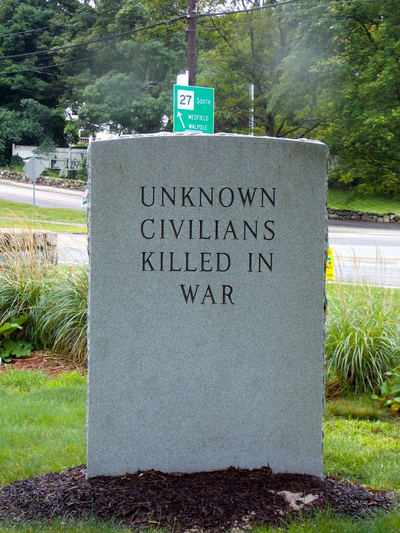
Stonewalk brought the monument to Ground Zero in September 2004
STONEWALK: America, Ireland, England, Japan & Korea
Global requiem peacewalk honoring civilian casualties of war
Stonewalk began with the one-ton granite stone memorial which had been placed on the grounds of The Peace Abbey in 1992 where it was unveiled at a ceremony which Muhammed Ali participated in. The stone is a memorial to those people around the world who tragically lost their lives in the course of military conflicts.
For years the Peace Abbey in Sherborn, Massachusetts was its home. Over a period of years, it became clear to its caretakers that the stone must share its mission and meaning with the people of the United States and the world. On it’s first pilgrimage, the memorial was taken to Arlington National Cemetery to serve as a reminder of the true cost of war. Arlington is known around the country as the home of the Tomb of the Unknown Soldier and a place where the people go and mourn for those who died in military conflict – American men and women of the four branches of military service. No mention is made of the civilian loss of life which number 9 out of 10 casualties in war. In fact, there is no official place in America where citizens can pause, reflect and mourn for civilian victims of war — men, women and children.
Stonewalk 2004 brought together members of Peaceful Tomorrows from New England, New York, Philadelphia and people along the way who wished to show their support for peace and to remember all those killed in war, including the civilian casualties too often dismissed as “collateral damage.” From July 26 through September 2, 2004 they walked from Boston to New York, pulling the 1400-pound granite memorial honoring the “Unknown Civilians Killed in War.”
Family members of 9/11 victims made a dramatic statement of solidarity with victims of terrorism, violence and war from around the world.
THE STORY OF STONEWALK
Stonewalk 1999 began with the one-ton granite stone which was placed on the grounds of The Peace Abbey in 1992 where it was unveiled at a ceremony which Muhammed Ali participated in. The stone is a memorial to those people around the world who tragically lost their lives in the course of military conflicts.
For years the Memorial called The Peace Abbey in Sherborn, Massachusetts its home. Over a period of years, it became clear that the stone must share its mission and meaning with the people of the United States … it went without saying that it should be taken to Arlington National Cemetery to serve as a reminder of the true cost of war. Arlington is known around the country as the home of the Tomb of the Unknown Soldier and a place where the people go and mourn for those who died in military conflict – American men and women of the four branches of military service. No mention is made of the civilian loss of life which number 9 out of 10 casualties in war. In fact, there is no official place in America where citizens can pause, reflect and mourn for civilian victims of war — men, women and children.
On July 4, 1999, a team of people from The Peace Abbey took the one ton stone, mounted it on a “caisson”, a cart that was made just for this purpose, and pulled it 500 miles in 33 hot, summer days from Sherborn over hundreds of hills and severe, black asphalt to Arlington. As the caisson went through the cities and communities of the east coast, townspeople joined in, either by cheering the walkers on, by offering them water, or by joining in, taking a handle and helping to pull the stone.
The stone made it to Arlington, but once it arrived, it was not allowed into the cemetery. Now the stone is on a mission to travel the world, bringing its message to communities everywhere that have been touched by the effects of war. This journey beyond the United States started on July 5, 2000 in Ireland.
The story of Stonewalk 1999 is chronicled below. To get a sense for what was happening as they walked, read the Daily Reports and Field Education Report written by Simon Augustine, a Harvard Divinity School Intern and a Stonewalker. To see how far the walk went each day, check out the Schedule and Route, or see what the media had to say about the journey at Articles about Stonewalk.
Stonewalk Introduction Pre-walk video to news stations to Arlington National Cemetery
Stonewalk Film website by Progressive Picture.
Stonewalk Trailer for Documentary WGBH Memorial Day Program.
Stonewalk News coverage of beginning of Stonewalk at UMASS Boston.
Stonewalk: 2004, 911 Families for Peaceful Tomorrows
Documentary: Boston to New York City.
Stonewalk New York City Footage, 2004.
Stonewalk Japan: 2005, 60th anniversary of the bombing of Nagasaki to Hiroshima.
Stonewalk Korea: 2007 Seoul, South Korea to the DMZ.
Above photos of the Caisson Cabin adjacent to the Peace Abbey Foundation building.
